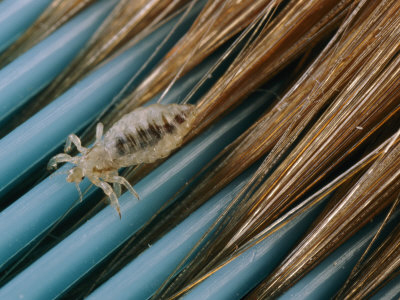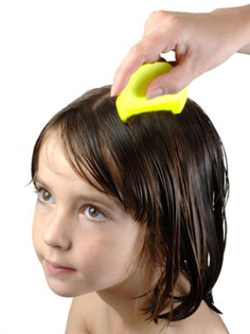
Not all people become allergic to the lice and these people can have head lice but have no itch or other clue to their presence.
Head lice are most common in children attending school, kindergarten or childcare. They are rare in babies. They are diagnosed by finding either the lice or their eggs stuck to the hairs close to the scalp. Unlike dandruff, nits cannot be combed out with a normal comb.
The lice live in the scalp laying eggs on the hair. The lice are about the size of a pinhead and most people only have 8-10 lice on their scalp so they may be difficult to see. In contrast, there may be hundreds of eggs (nits) attached to the hair which can be more easily found. Head to head contact or using the same hats, headbands or combs passes the lice from person to person. The lice cannot live away from the human body for more than a few minutes.
How can it be prevented?
All affected members of the family should be treated to prevent further infection within the family. They should not share combs, brushes or headwear. Brushes and combs should be washed with very hot water and carefully dried.
How can it be treated?
Head lice products should only be used if you can see lice or eggs in the child’s hair. To check for head lice you can use normal hair conditioner and a lice comb, a method that can also be used as a treatment.
To treat using this method, comb hair conditioner through dry hair from scalp to tip of hair using a lice comb. Work through the hair in sections wiping the conditioner off the comb onto a tissue to remove all the eggs and lice. Each section or part should be combed through at least 5 times. Rinse the whole head with warm water when no more lice or eggs are seen on the comb. The problem can occur again if any live eggs remain on the hairs. The child should be checked every week using this method.
There are a number of head lice lotions or shampoos available from the chemist. Not all are suitable for young children or pregnant women so check carefully with the chemist. These preparations can be effective when applied as directed on the instructions. Treatment normally requires two applications of the preparation seven days apart to remove all lice and eggs from the hair.
The head may remain itchy for a week after lice have been removed. Scratching may cause the skin to become infected with weeping skin, swollen glands and mild fever. If this occurs see your family doctor.
It is still important to check the child every week using the ‘Conditioner and Comb’ method for 2-3 weeks after using an insecticide to ensure the treatment has been effective.
-
Head lice are most common in school children. It is uncommon in babies
-
The lice are not seen easily, but the eggs are seen attached to the hair
-
Head lice lotions or shampoos should be used as directed and repeated a week later
-
Hair conditioner can be applied to the hairs making it easier to remove eggs and lice with a lice comb
-
Conditioner and the lice comb should be used until no eggs are seen on hairs
-
All affected members of a family should be treated to prevent further infection within the family
-
Combs, brushes, hats and headbands should not be shared

